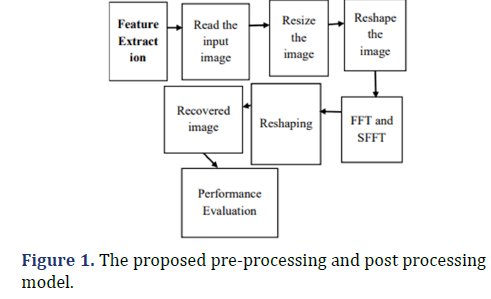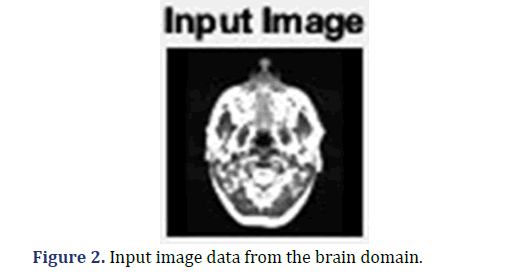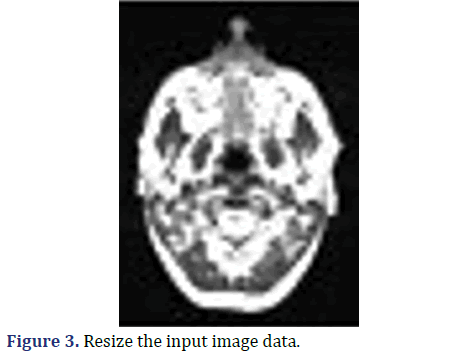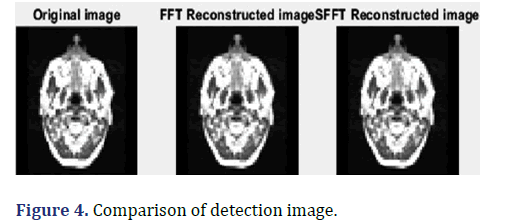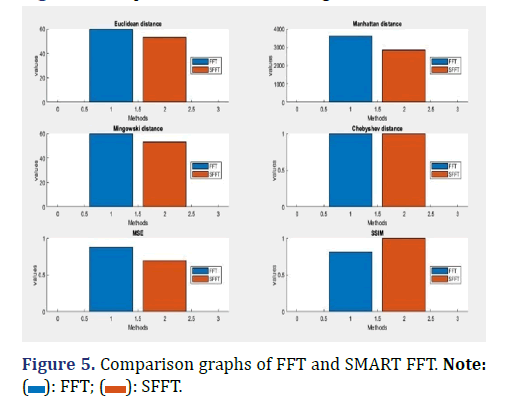Research Article - Journal of Contemporary Medical Education (2024)
Revolutionizing UWB Image Reception: Advanced Signal Detection with Smart FFT for Unprecedented Resolution and Dynamic Range
Prasanna Kumar Daram*Prasanna Kumar Daram, CLUPAV Scientific PVT LTD, Palwancha, India, Email: daram.5@wright.edu
Received: 12-Mar-2024, Manuscript No. JCMEDU-24-129290; Editor assigned: 15-Mar-2024, Pre QC No. JCMEDU-24-129290 (PQ); Reviewed: 29-Mar-2024, QC No. JCMEDU-24-129290; Revised: 05-Apr-2024, Manuscript No. JCMEDU-24-129290 (R); Published: 12-Apr-2024
Abstract
Objective: One of the challenges facing modern digital radar receivers is the detection of images with high dynamic range and proximity to one another. An innovative Smart FFT (SFFT) based receiver is presented in this paper. Different undersampling rates are taken into consideration for a set of big data to detect more image data more accurately without any prior knowledge. A tumor is a mass of tissue formed by the extra cells. Cells proliferate abnormally and uncontrollably in brain tumors. This study examines separation techniques utilized in biomedical image processing and investigates methods that can improve extraction. The suggested Fast Fourier Transform (FFT) based receiver uses signal detection image, a squarer, an adaptive gain- control amplifier, and other components to analyze incoming signal characteristics and provide real-time accomplishment of these tasks. To present improvements over currently in-use devices in this field, the simultaneous image accommodations and their properties are supplied.
We hypothesised that the reason patient’s other fingers were spared from the effects of rheumatoid arthritis was due to the protection of the PIP and DIP joints of the fingers and further discussed the potential ways in which wearing gold jewellery may be protective of joints and tissues from inflammatory joint disease.
Keywords
Brain; Contemporary; Image extraction; Smart FFT; Signals
Introduction
Many of the methods put forth to enhance the performance of digital wide band receivers are computationally demanding and have hardware limitations that limit their real-time performance. In digital wideband receivers based on the Fast Fourier Transform (FFT) were presented [1-3]. Since the Instantaneous Dynamic Range (IDR) determines the receiver’s effective channel width, it is more affected by a higher precision data format and a longer FFT operation. To lessen the FFT operation’s computational complexity, several strategies have been put forth. The discrete Fourier transform’s general multiplication operations are replaced with shift, addition, or subtraction operations by the FFTs used in the Monobit receiver design and the Receiver-On-a-Chip (ROC) [1,2]. Two signals with an IDR of 5 dB in the 1-GHz Bandwidth (BW) can be detected simultaneously by the monobit receiver using a 2-bit Analog-to-Digital Converter (ADC) and a 256-point FFT implemented by a four-point kernel function. In, an enhancement of the Monobit receiver that raised the two-signal IDR to 18 dB was introduced [2]. The development of digital Ultra-Wide Band (UWB) receiver systems is ongoing. Using FFT as the fundamental digital technique, reasonable performance was shown in [1-3]. Fast ADC sampling rates are used by FFT-based receivers to increase bandwidth, and a large number of data points must be processed. Simultaneous detection of multiple signals with ultra-high resolution is crucial. It can be difficult to process million-point data in UWB signal processing using computationally demanding FFT operations. Furthermore, the cost of FFT hardware would be very high. In addition, applications requiring million-point FFTs are sparse, meaning that all of the energy is contained in a small number of frequencies, with the remainder being noise [4].
The spontaneous electrical activity recorded by cerebral cortex nerve cells is known as the Electroencephalogram (EEG), and it contains a wealth of information about pathology and physiology [5]. An objective technique for assessing the condition and function of the brain is the measurement of prominent features in EEG signals. As a result, EEG is considered the gold standard for identifying brain anomalies, particularly epilepsy [6,7]. Excessive synchronization of neuronal discharges is the cause of epilepsy, a neurological disorder [8]. The conventional approach, which involves visually monitoring the long-term EEG recording, is a laborious and highly subjective procedure. Neurologists would benefit from a more efficient algorithm that accurately and automatically detects seizures to reduce workload and provide patients with timely intervention.
Digital receivers are superior to analog receivers in that they can collect data for longer periods and extract signal information using progressive and flexible digital techniques [9]. The Multiple Signal Classification (MUSIC) method was created by Ralph Schmidt and first presented in 1986 [10]. Since the eigenvectors of the signal and noise subspaces are orthogonal, it employs the eigenvalue decomposition technique to divide the input signals into the signal and noise spaces. Because of this, the ability of music to separate signals with a close frequency separation has been well-known and researched.
Wideband receivers are now more important than ever in signal detection and tracking due to the widespread use and sophisticated development of communication products. It was suggested to use a wideband signal detection circuit that can simultaneously detect wideband electrical field sensor signals with high sensitivity [11]. A low noise figure and high gain packaged wideband receiver RF front end are designed [12]. Identifying and analyzing the sources of Radio Frequency (RF) signals is one of the main uses for a contemporary wideband receiver [13]. In addition to having to quickly and with acceptable sensitivity intercept a very wide frequency band in real-time, current receivers also have to detect multiple signals with high-frequency resolution, good Instantaneous Dynamic Range (IDR), and an unknown number of input signals. In the meantime, after the standard receiver processing, the receiver may report false alarms or miss signals due to the lack of prior knowledge regarding the quantity of incoming signals. In this instance, a novel design architecture with a high two-signal IDR is offered to accurately detect the frequencies of two incoming signals.
This paper proposes a novel Smart FFT (SFFT) method that reduces computation compared to the conventional FFT by using only a subset of data points. The data points are chosen with an under-sampling rate of nine taken into account. An example of this would be a 2.56 GSPS ADC, which in 12.8 μs of sampling produces 32,768 data points. By employing the undersampling technique, the FFT operation can be carried out with mere 4,096 data points (roughly 1/9 of 32,768) as opposed to 32,768 data points, which incurs a significant computation penalty and consumes more receiver power. However, with an error of less than 0.625 MHz (1 frequency bin), multiple signals that are at least one frequency bin apart are detected using the undersampled data.
Literature survey
Innovative algorithms with simpler implementations for high-resolution wideband receivers are being actively sought after by researchers and engineers [11,14]. To reliably detect two simultaneous high dynamic range signals, even when their signal frequencies are extremely close, this paper presents a wideband digital receiver with adaptive gain control and dynamic thresholding. The suggested Fast Fourier Transform (FFT) based receiver uses two FFTs, an adaptive gain-control amplifier, a squarer, two analog-to-digital converters, and an adaptive gain-control amplifier to analyze the characteristics of incoming signals and provide real-time completion of these tasks. The wideband receiver provides high dynamic ranges, sensitivity, and a high probability of intercepting over large instantaneous RF bandwidths. To show how these two simultaneous signal accommodations improve upon the receivers currently in use in this field, their characteristics are provided.
The EEG matrix has been created using a novel application of the Fast Fourier Transform (FFT). Additionally, a PCA Neural network (PCANet) is made to deduce hidden information from the EEG signals’ frequency matrix. A Support Vector Machine (SVM) is then trained to recognize epileptic seizures using these deep features as inputs [15,16]. Two reliable databases, namely Database A form Bonn University and Database B from Children’s Hospital in Boston, are used in the experiments. We have also assessed the impact of each parameter on the suggested scheme to produce the best possible model with improved expansibility and generalization. The suggested feature learning technique used in this work has shown to be very helpful in differentiating between seizure events in both short and long EEG recordings. In seven problems, the experimental results derived from the analysis of database a show an accuracy of at least 99%. The vast majority of receiver designs in use today are digital. Both narrow-band and wideband receivers will be showcased. The wide- band receivers are used to intercept radar pulses and have an instantaneous bandwidth of about 1 GHz. The primary use of current narrowband receivers, which have an instantaneous bandwidth of up to 50 MHz, is to receive communication signals. We’ll talk about two different approaches to designing wide-band receivers. The traditional digital receiver is one of them. The other is known as the monobit receiver, and it can be constructed on a single chip, despite having somewhat worse performance in some areas. Software is the best place to use narrow-band receivers because of their increased adaptability to changes.
This is known as the FFT compensation technique. Five signals at most can be found using this compensation method [17]. On the other hand, after using the compensation method, the frequency bin of the weaker signal is eliminated if it is close to a stronger signal. Consequently, the weaker signal is undetectable.
The recommended FFT processor can handle variable lengths ranging from 64 to 4096 and is built with a memorybased FFT architecture. Furthermore, a floating- point operator is incorporated into the design to avoid fixed-point operators’ performance deterioration. FMCW radar signal processing calls for magnitude calculation operations based on the FFT results to detect the target, accumulation operations to enhance the target’s detection performance, and windowing operations to increase the target detection rate by reducing clutter side lobes [18]. Furthermore, in certain uses, like taking vital signs, the phase of the FFT result needs to be computed. Generally speaking, the software handles the other FMCW radar signal processing while the hardware only handles the FFT. They present the piecewise constant window blocking FFT (PCWBFFT) technique in this paper. This work aims to demonstrate how spectrograms, which are composed of multiple spectrum lines, can be generated with a very large number of samples (N) in an FFT frame for each spectrum line calculation [9]. The N samples in the PCWBFFT are divided into K consecutive time slots, with M samples in each slot. This paper shows the PCWBFFT method’s thorough derivation process and uses simulation results to illustrate how to apply the method.
Research Methodology
Data extraction
The proposed model is shown in (Figure 1). The input image must first be read into Matlab from the datasets to extract features from the images that will be used as input. Aircraft, Brain Images, Cars, and Ships are the four 3 categories of image datasets available. It is necessary to resize the input image to 64X64 rows and columns after reading it. To prepare the resized input image for additional analysis, you must then reshape it into a single vector value.
Data pre-processing
The term “image pre-processing” refers to activities performed on images at the lowest possible level of abstraction to improve the image data by enhancing certain key features or suppressing undesirable distortions. It doesn’t add more information about the image. Its techniques make use of significant image redundancy. Pixels next to each other that correspond if a distorted pixel can be identified, and if all objects in real images have brightness values that are the same or comparable it can be recovered from the picture as the mean value of the adjacent pixels. A MatLab-created image preprocessing tool allows for numerous brightness transformations and local pre-processing techniques
Proposed smart FFT
Sampled data is obtained for a 2.5e9 GHz sampler from the technological beneficiary’s front end. Consequently, a 4,096-point FFT is applied to the initial 4,096-point data set after 32,768 data points are received. The values of the adjacent bins rise in proportion to the message strength. For closely weak images, this phenomenon restricts detection. Every identified picture bin and its neighbor bin are recorded for the SFFT algorithm. One and zeros make up the binary filter. Bins that have no signal above the threshold are assigned logic ‘0’. In the following decision-making block, this binary filter is applied. We must reshape the reconstructed data value as a 64X64 rows and columns matrix value (Image data) after FFT and our smart FFT. Because FFT and SmartFFT must be used to reconstruct the image. Next, format the reshaped data value in Uint8. The original image data is now recovered using the proposed Smart FFT technique as well as FFT. The Chinese reminder algorithm plays a role in the bucketization procedure. For instance, a bucket containing four data points is to be filled with twelve consecutively digitized data points. A five percent undersampling rate is chosen. First, let’s select the first data point, and then we can add the sixth to the basket. Following the selection of the eleventh point, we count forward in a circle. The fourth point comes after the eleventh point. We need to bucketize the 32,768 data points in this paper into a 4,096 data point basket. This receiver’s bucketization employs an undersampling rate of 9. A 4,096-point fast Fourier transform is applied to the undersampled bucket. Any image that is above the threshold is first considered to be a signal detection. Next, the SFFT filter eliminates the local peak bin’s surrounding bins. However, in this case, the 32768 data points must be bucketed into 4096 data points using the bucketization process. Apply FFT to the data points after that. We refer to the entire procedure as our proposed SMART FFT (bucketization+FFT).
Performance evaluations
Finally, we have to analysis the recovered image data from FFT and smart FTT with the corresponding original image data for performance evaluations and comparisons. For that we have to use performance analysis, Euclidean distance, Manhattan distance, Mingowski distance, Chebyshev distance, Mean Square Error, PSNR, SSIM.
Proposed Results and Analysis
All of the outcomes from the models we recommended are presented in this section. All of the results are presented stepby-step with figures and an explanation of the findings. We briefly summarize and compare the performance of our proposed model with a few of its closest competitors and previous research investigations in Section. To evaluate the performance of the model we proposed, we used the input image data from the brain domain. Based on the FFT results for the original images, a combination of the clustering algorithm for feature extraction and FFT is applied to enhance the network performance. Then resize the input image data. It shows (Figures 2 and 3).
Table 1 displays the FFT results on the dataset obtained by applying the recommended approach, which combines feature extraction and FFT. In comparison to the standard FFT, the recommended method’s exactness improved on the evaluation data as shown in (Table 1).
| FFT image | |
|---|---|
| Euclidean distance | 60.0916 |
| Manhattan distance | 3611 |
| Mingowski distance | 60.916 |
| Chebyshev distance | 1 |
| Mean square error | 0.8816 |
| PSNR | 48.7121 |
| SSIM | 0.8111 |
The tumor was detected with commendable results thanks to the proposed methodology. The dynamic range and the frequency separation are directly correlated. The dynamic range vs. frequency bin separation that can be achieved with various SFFT under sampling rates is displayed of detected image in (Figure 4). The comparison of the FFT and Smart FFT technique’s performance parameters and strengths are in (Figure 5).
Table 2 displays the findings of SFFT on the dataset using the suggested method (i.e., combining the feature extraction and SFFT). Comparing the proposed method to the conventional SFFT, there was an improvement in terms of exactness on the test data as shown in (Table 2).
| Smart FFT image | |
|---|---|
| Euclidean distance | 53.3198 |
| Manhattan distance | 2843 |
| Mingowski distance | 53.3198 |
| Chebyshev distance | 1 |
| Mean square error | 0.6941 |
| PSNR | 49.7056 |
| SSIM | 0.9976 |
Conclusion and Future Scope
Contemporary wideband receiver systems must be able to detect images in environments with a high dynamic range and resolution. An approach that is frequently used to increase image detection resolution is multiple signal detection with ultra high resolution and dynamic range for UWB digital receivers for images. This work presents a high-frequency resolution adaptive thresholding method for close-image detection of two high dynamic range signals using the wideband receiver system’s gain control amplifier. The receiver employs two methods:
1. A squared data FFT with an adaptive gain control amplifier to break the limit of single image detection with very close FFT processing.
2. A single threshold in a non-squared data FFT to increase the two-signal IDR at least 4 dB. This two- FFT-based wideband receiver can be implemented into real-time FFT-based radar systems since the FFT algorithm is frequently used in real-time systems. It has been demonstrated that the suggested method is a reliable, accurate model with excellent extensibility and flexibility for real-world application. The approach will be improved in subsequent work to streamline the program into clinical development. Additionally, we intend to investigate the possibility of diagnosing additional brain disorders like depression, schizophrenia, and more using the recommended design.
References
- Pok DS, Chen CI, Schamus JJ, Montgomery CT, Tsui JB. Chip design for monobit receiver. IEEE Trans Microw Theory Tech 1997;45(12):2283-2295.
- Chen CI, George K, Mccormick W, Tsui JB, Hary SL, Graves KM. Design and performance evaluation of a 2.5-GSPS digital receiver. IEEE Trans Instrum Meas 2005;54(3):1089-1099.
- Emmert JM, Cheatham JA, Jagannathan B, Umarani S. An FFT approximation technique suitable for on-chip generation and analysis of sinusoidal signals. Proceedings 18th IEEE Symposium on Defect and Fault Tolerance in VLSI Systems 2003; 361-368.
- Aydemir E, Tuncer T, Dogan S. A Tunable-Q wavelet transform and quadruple symmetric pattern based EEG signal classification method. Med Hypotheses 2020;134:109519.
[Crossref] [Google Scholar] [Pubmed]
- Zhang T, Chen W, Li M. Complex-valued distribution entropy and its application for seizure detection. Biocybern Biomed Eng 2020;40(1):306-323.
- Nagarajan L, Ghosh S, Palumbo L. Ictal electroencephalograms in neonatal seizures: Characteristics and associations. Pediatr Neurol 2011;45(1):11-16.
[Crossref] [Google Scholar] [Pubmed]
- Wang D, Ren D, Li K, Feng Y, Ma D, Yan X, et al. Epileptic seizure detection in long-term EEG recordings by using wavelet-based directed transfer function. IEEE Trans Biomed Eng 2018;65(11):2591-2599.
[Crossref] [Google Scholar] [Pubmed]
- George K, Chen CI. Multiple signal detection digital wideband receiver using hardware accelerators. IEEE Trans Aerosp Electron Syst 2013;49(2):706-715.
- Schmidt R. Multiple emitter location and signal parameter estimation. IEEE Trans Antennas Propag 1986;34(3):276-280.
[Crossref] [Google Scholar] [Pubmed]
- Tong Z, Shuguo X. Design of a wideband signal detection circuit for electrical field sensor. IEEE 2016; 1:301-303.
- Gupta N, Ghosh NN, Kumar D, Dutta A. A Sub-2 dB NF, 0.3-3 GHz packaged bandwidth extended wideband receiver front-end. IEEE Trans Circuits Syst II Express Briefs 2019;67(3):491-495.
- Gu J, Goetschalckx M, Mcginnis LF. Research on warehouse design and performance evaluation: A comprehensive review. Eur J Oper Res 2010;203(3):539-549.
- Liu F, Chen CI. High two-signal dynamic range and accurate frequency measurement for close frequency separation wideband digital receiver using adaptive gain control and adaptive thresholding. Integration 2020;72:72-81.
- Tsui JB, Stephens JP. Digital microwave receiver technology. IEEE 2002;50(3):699-705.
- Li M, Chen W. FFT-based deep feature learning method for EEG classification. Biomed Signal Process Control 2021;66:102492.
- George K, Chen CI. Multiple signal detection and measurement using a configurable wideband digital receiver. IEEE Instrumentation & Measurement Technology Conference IMTC 2007; 1-5.
- Heo J, Jung Y, Lee S, Jung Y. FPGA implementation of an efficient FFT processor for FMCW radar signal processing. Sensors 2021;21(19):6443.
[Crossref] [Google Scholar] [Pubmed]
- Wu C, Elangage J. Very long-length FFT using multi-resolution piecewise-constant windows for hardware-accelerated time-frequency distribution calculations in an ultra-wideband digital receiver. Sensors 2022;22(23):9192.
[Crossref] [Google Scholar] [Pubmed]








